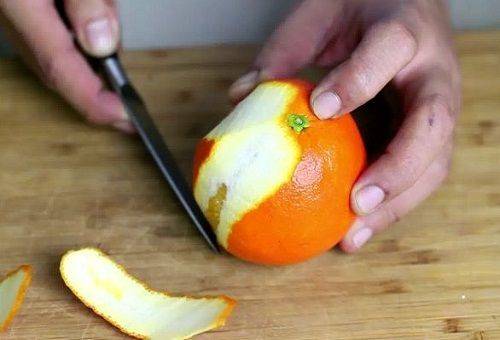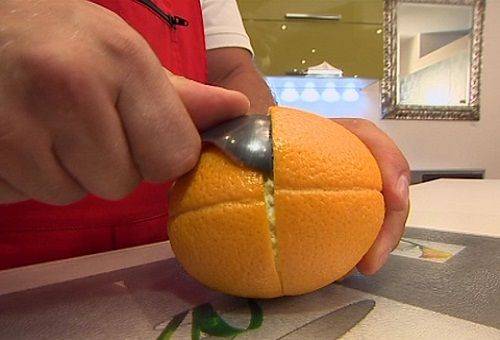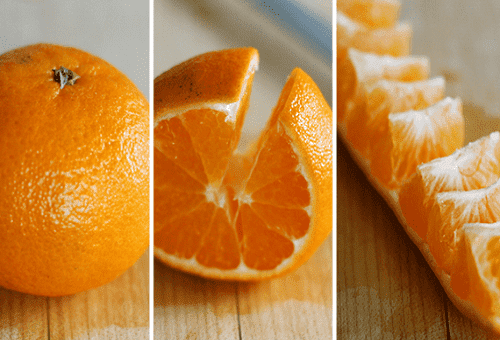Simple and effective ways to peel oranges: with hands, spoon, knife
Many people deliberately refuse the pleasure of eating juicy citrus just because they don’t know how to quickly peel an orange. The prospects of splashing yourself and others with juice, getting hurt on sharp seeds, or struggling for a long time with the thick peel stop even the most ardent admirers of the fruit. In fact, everything is not as problematic as it seems. You just need to familiarize yourself with specially developed techniques and practice a number of skills. Ultimately, the entire procedure will take from 10 to 20 seconds, depending on the method chosen.

An important point is the process of choosing the right fruit. It should feel firm to the touch, heavy and bright orange. Unripe products with a yellowish color and with green areas not only have low taste characteristics, but are also very reluctant to part with the peel. Spotted or wrinkled fruits will fall apart in your hands into slices covered with a dense peel.
How to peel an orange with your hands, a knife or a spoon
Before using one of the methods, you need to prepare the fruit in a special way. According to many experts, this facilitates subsequent exposure to the peel and gives the pulp maximum juiciness. Place the product on a cutting board or countertop, cover with your palm and press lightly. Spin the fruit with your second hand for 15 seconds, without increasing or decreasing the pressure.
Next, we use one of the following techniques:
- Cleaning by hand. First, cut off a small section of peel from one of the poles of the sphere. To carry out the manipulation correctly and not get hurt, you need to fix the orange with one hand and place the thumb of the other hand on the cut. We push our finger under the skin, but not inside! Scrolling the orange with your hands, separate the peel from the pulp without removing the skin. We continue this way as long as our finger is long enough. Only then do we tear off everything unnecessary and complete the manipulation in the same way. If you do everything correctly, you will be able to quickly get to the pulp without damaging it.
- Cleaning with a knife. If the peel of the fruit is very dense, you can use a knife. It should be well sharpened, with a sharp tip. First, cut off the top or make a deep cut on it. Next, we begin to cut the peel from the orange in a spiral, keeping the tape width to 2.5 cm. During the manipulation, you can adjust the depth of penetration of the knife, trying not to touch the pulp. Even if at first smooth movements will be difficult, and the flesh will sometimes be cut, after a short practice the peel will come off in a few seconds in one uniform flap. This option is not suitable for processing oranges with very thin peels.
- Cleaning with a spoon. Take an orange, a sharp knife and a tablespoon. The last tool should not be very deep; it is better if it is as flat as possible. We cut off the dense sections of the skin on the two poles of the citrus, make one longitudinal shallow cut with a knife, connecting the top and base of the fruit. The depth of the cut should be minimal; it must not reach the pulp. We insert a spoon under the peel and begin to separate the skin from the pulp with gentle movements.Ideally, you need to do everything so that the aromatic skin comes off in one piece.
Tip: Even with such careful methods of influence, you can touch the pulp and fill everything with sticky juice. To prevent this from happening, during the training phase it is better to cover your hand with a thin paper napkin and use it to take the orange. This will also help to evaluate the quality of the work performed at the end of the manipulation.
How to peel an orange in 10 seconds and immediately access the segments
There is another way to peel an orange that is more like a trick. During the cleaning process, it is possible to cut the fruit in just 10 seconds, and the risk of juice release is minimal, you just need to reach a certain level of skill. Take an orange and use a sharp knife to cut off the thick skin at the poles. In this case, the skin on both sides should be cut so that the location of the segments can be determined. But even if this is not possible, contamination of surrounding objects will be minimal.
By eye, we determine the location of the furrow between any two slices, place the fruit on its side and make a cut along this furrow, reaching to the center of the orange. We put the knife aside, insert our thumbs into the recess and, with one sharp movement, divide the citrus into halves.
You can’t hesitate, this can end with simply squeezing the pulp and an abundance of juice. If everything is done correctly, the fruit will open like a book, the slices will separate and you just need to remove them from the peel. Just a few training sessions and you can surprise your friends with your skill and sleight of hand.
The above methods allow you to quickly and efficiently peel your favorite fruit without spoiling its pulp, without losing a drop of precious juice, and without ruining the mood of everyone around you.These methods are highly not recommended for use in relation to other similar fruits; working with each fruit has its own specifics. We must not forget that in some people the area around the nails is highly sensitive and reacts extremely negatively to the acid contained in oranges. They will have to use a knife or cut the fruit into individual slices.




